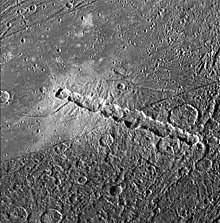Enki Catena

Enki Catena is a 160 km long chain of craters on Jupiter's largest moon, Ganymede . It consists of at least 13 impact craters that are almost in a straight line. It is named after the Sumerian god Enki .
location
The position of Enki Catena is 39 ° North, 14 ° West. It lies between the eastern part of the crater-rich Perrine Regio and the lighter, rift system Sicyon Sulcus , of which some furrows can be seen in the picture above left. However, the impact has nothing to do with this tectonic structure.
Emergence
The chain of craters was created by the impact of a few kilometers of rock that disintegrated into several parts shortly before it hit the surface of the moon. The individual craters have a diameter of 10 km or more, which indicates a size of the individual parts of 0.5 to 1 km. It is not yet clear whether it was a cometary nucleus or a porous small asteroid in the early days of the moon . At that time there were numerous collapses of cometary nuclei on planets and larger moons, as most recently in 1994 with the Comet Shoemaker-Levy 9 , which was torn apart by the tidal forces of Jupiter long before the impact .
Other chains of craters
There are other such linear chains of craters on Ganymede . Similar structures knows the Planetary Geology on other planetary celestial bodies , such as the Gipul Catena external on Ganymede neighboring moon Callisto (also a straight chain of impact craters).
There are similar structures on the Earth's moon . There, however, they can also be of tectonic or volcanic origin, for example as the remains of collapsed lava tubes . The latter cannot be assumed for the Enki Catena because the crustal material of Ganymede is much more porous than that of the Earth's moon.
literature
- Patrick Moore et al .: Atlas of the Solar System (chapter Jupiter's moons). 465 pp., Herder-Verlag Freiburg-Basel-Vienna 1986
- Heather Couper , Robert Dinwiddie et al .: The Planets. A journey through our solar system (Chapter Ganymede). 256 pp., Dorling Kindersley Verlag, Munich 2015
- Gazetteer of Planetary Nomenclature